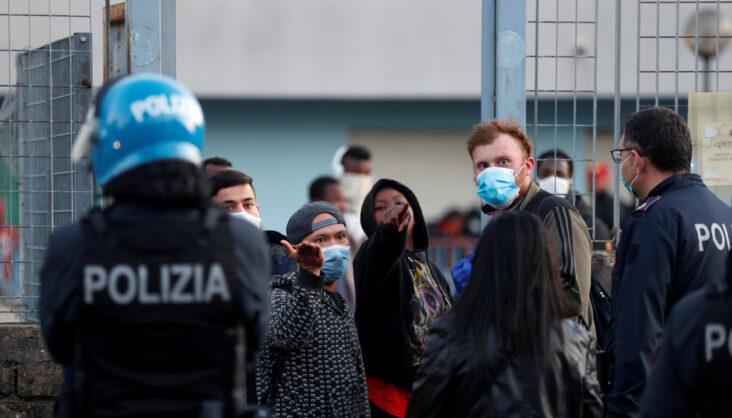Africa-Press – Lesotho. As history is made up of big names and events, the lives of ordinary people are often pushed aside.
That has been the case with thousands of migrants who are forced to leave their homes across Africa and Asia bound for Europe, and whose stories remain untold.
In recent years, the fear of a growing migration flow has resulted in stricter and uncoordinated migration policies in the European Union (EU) from which the lives of migrants get enmeshed.
This system for migration control takes away people’s rights and dignity, dashing their hopes for a better future. Stories of forced migrants stretch over years and can become – like the case of one man, whom we’ll meet later – a striking chronicle of rejection.
Asylum seekers wait years before they are granted protection and many never even get that.
Especially people from sub-Saharan and North African countries are in most cases categorised as economic migrants; therefore not deserving of asylum. But when people live in extreme poverty, the dividing line between an asylum seeker and an alleged economic migrant becomes blurred.
These measures have been passed under the mistaken belief that there was a relationship between the increase in crime rates and immigration, a correlation that studies have proven otherwise.
As permits to seek employment do not exist for migrants and it is impossible for an unqualified worker to get a job offer while still in his or her home country, people feel the only solution left is to enter the EU with the hopes of finding a safer and better life. But given there are no direct ways in their situation to enter Europe, they do so illegally.
In Italy, as a result of the Italy-Libya agreement in 2017 and tougher border control, the migration flow – which had peaked since 2011 following the “Arab Spring”- has significantly dropped in the past two years.
Nonetheless, the new migration policies put into effect by the Italian Government elected in March 2018 were designed to discourage and securitize migration.
The “Salvini decree” (Italian law decree n.113 of 2018, converted into law n. 132/2018) introduced a number of restrictive measures such as the exclusion of asylum seekers from integration services, the reduction in the scope of international protection, stricter provisions on subsequent asylum applications, and a wider spectrum of legal violations since international protection can be refused or revoked.
Lack of certainty and loss of hope can be hard to endure when protracted too long. It can too often push a person to acts of desperation. These measures have been passed under the mistaken belief that there was a relationship between the increase in crime rates and immigration, a correlation that studies have proven otherwise.
Substantial literature shows that the crime rates increase only when migrants report a low quality of life and cannot access the labor market, as well as when people have no hope of being granted protection and the right to stay and/or work legally.
To better illustrate the hardening system increasingly in place for an economic migrant, we follow the story of Patrick*(not his real name), an illiterate handyman from Egypt. In 2003, at the age of 23, he left Egypt due to economic and political reasons, and reached Italy on a boat.
During his time at one of Italy’s reception centres, where he came across other Egyptians (many of whom still remain), he found out that he would receive very little international protection there.
So he opted to escape from the centre before trying to apply for asylum. He lived undocumented in the country for five years, and then moved onto France, Holland, Germany and then Switzerland where he thought he would have better chances of finding stability. But each time he was rejected and deported back to Italy.
That is a directly a cause and effect of the Dublin Regulation (EU n. 604/2013), which establishes that asylum seekers must be sent back and remain in the first European country from which they entered.
When he reached Belgium in 2010, Patrick worked while applying for asylum. Nonetheless, after seven years he was once more denied asylum and deported back to Italy, “I was put on a plane to Rome”, says Patrick during an interview with his lawyer, adding “it happened once again.
” With no options left, Patrick decided to apply for asylum in Italy.
“At the migration office at the airport I met a very gentle Egyptian cultural mediator; she suggested that I apply for asylum in Italy and I trusted her,” he explains.
The Italian Asylum Commission heard Patrick’s application in March 2018, but the result was negative, so he appealed in September. In the meantime, he was hosted in a first-tier reception facility (CAS, Center of Extraordinary Reception).
Under law n.132/2018, this type of center only provides basic needs and offers no services for integration. Patrick found himself, once again, caught in the monotony and precariousness of waiting without work, with no money and nearly no possibility of being granted protection.
Lack of certainty and loss of hope can be hard to endure when protracted too long. It can too often push a person to acts of desperation. One afternoon while in the city with friends, they entered a clothing store and stole items for a total value of 90 euros.
Security stopped them on the way out and the situation quickly escalated. They were brought to a court and sentenced for robbery, but were released on the condition that they sign in at the police station three times a week.
Like many other migrants caught in a similar situation, Patrick is an honest man with no previous criminal record or warning. He immediately regretted what had happened and followed through on his legal obligations.
But the situation further complicated his search for a legal job in Italy. Patrick’s life quickly took a nosedive. Caught in limbo, he decided to leave Italy, even if this was against the law.
He returned to Belgium, where he reapplied for asylum, and currently remains while awaiting a response. But as has been the case thus far, his Egyptian nationality is not “convincing” enough, nor is his tale of woe in securing a chance to be granted asylum.
Should he decide to return to Italy he will be jailed. “He knows that if he does so he will go to prison as a result of escaping the obligation to sign in following his conviction.
The trouble is that even if he does his time in Italy, he cannot aspire to be granted asylum afterwards, nor can he easily apply for a working visa with a criminal record”, says Claudia Monti, the legal advisor who has followed Patrick’s case since his time in Italy.
What does the future look like for Patrick and others like him? Most likely invisibility, until the day he is caught and sent back to his country of origin.
At present, he has nowhere to stay legally. Years and years of denied permits and living on the edge of society pushed him to make one mistake for which he will be paying for the rest of his life.
Statistics on the average duration of the whole asylum procedure are difficult to obtain, given the multilayered nature of the process (first instance decision, appeal, cassation), but in some cases it can take up to three or four, even five years.
Is it conceivable that a two-decade chronicle of travelling across the EU means nothing for the purpose of “regularisation”? How resistant does a person have to be to endure the same ordeal as Patrick and others like him? And, above all, is it fair?
For More News And Analysis About Lesotho Follow Africa-Press






